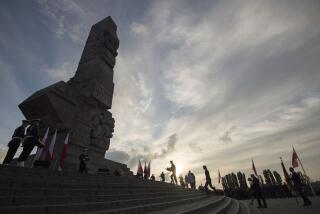Poland Honors Katyn Forest Dead : Many Blame Soviets for Wartime Massacre of 15,000
- Share via
WARSAW — More than 40 years after the fact, the Polish government has quietly raised a monument to the memory of as many as 15,000 Polish officers who were massacred in World War II in the Katyn forest of the Soviet Union.
The Germans, who exhumed some of the bodies in 1943, accused the Soviets of killing the officers. The Soviets accused the Germans. Most Poles and many independent historians hold the Soviet Union responsible.
The Katyn monument, the first in Poland, is a massive cross, 10 feet high, formed from rough-hewn blocks of white granite and set in a plot about 10 yards on each side. The cross was erected about a week ago in Warsaw’s main municipal cemetery, with no public announcement or ceremony.
An elderly caretaker at the Powazki Cemetery said Monday that the granite cross had been set up “at the end of March.” When asked who put it up, he shrugged his shoulders and said, “ Nasz “--”ours”--an apparent reference to the Polish authorities.
Official Soviet Version
An inscription chiseled in thick letters on an adjacent block of granite accepts the version of the massacre officially advanced by the Soviet Union and the Polish government, that the officers fell victim to “Hitlerite fascism.” But it omits the date of their deaths--the crucial determinant of responsibility for an act that still stirs deep emotions in Poland.
The Katyn massacre remains one of the most sensitive areas of Soviet-Polish relations and is a source of bitter anti-Russian feeling among ordinary Poles.
Most of the victims were not professional officers but reservists--scientists, lawyers, doctors, businessmen and civil servants--drawn from the cream of Polish society.
In April, 1943, the Germans announced the discovery of more than 4,000 corpses of Polish officers in the Katyn forest near the Soviet city of Smolensk on the Dnieper River, an area the Nazis had held since the summer of 1941. The bodies of another 11,000 Polish officers who disappeared are presumed to lie nearby.
Germans Accused Soviets
The Germans accused the Soviets of executing the officers in April, 1940, after taking them prisoner the previous September in the opening weeks of the war, when Adolf Hitler and Josef Stalin divided Poland between them under the terms of their nonaggression pact.
The Soviets denied the Nazi charges, in turn accusing the Germans of killing the officers after invading the Soviet Union in June, 1941, and overrunning Smolensk.
Initially, the Soviets said that German forces had shot the officers in the winter of 1941, but they discarded this version after it was noted that the exhumed corpses were in summer uniform.
The officers were held by the Soviets in three large camps near Smolensk and had been allowed to write to their families until the spring of 1940. In May of that year--14 months before invading German forces took the area--the letters stopped. The Germans were later to put on public display thousands of newspaper clippings, postcards and other items found on the bodies that bore dates no later than April, 1940, when Katyn was still in Soviet hands.
When the Soviets retook the Smolensk region, in September, 1943, they carried out their own inquiry, which emphasized that the officers had been shot with German bullets. The Soviets produced a handful of items from the bodies purportedly dated in 1941, but they refused to allow the International Red Cross to examine the evidence.
In 1941, before the bodies were found, Poland’s wartime government in London had demanded that Moscow explain the fate of the 15,000 missing officers. Stalin is reported to have replied that they had fled across the Soviet Union into Manchuria. When the Germans found the bodies, and the Polish authorities in London then demanded a neutral inquiry, Stalin broke relations with the London Poles.
“To the satisfaction of most neutral observers, Soviet guilt is established beyond reasonable doubt,” the British historian Norman Davies wrote in his 1982 history of Poland, “God’s Playground.”
“The Katyn massacre is the only ‘Nazi war crime’ on Soviet territory which the Soviets never mention,” Davies noted. “In Polish eyes, this one crime has become the symbol for countless other, unrecorded atrocities committed by the Soviet Union against the Polish nation.”
A monument to the victims at Katyn was one of the demands made by Solidarity, the independent labor union, in 1981 before it was outlawed. Solidarity put up a small cross in the Powazki Cemetery that year, but it was taken down overnight, apparently by the authorities. In 1983, the government put a wooden fence around the site and announced that it would build an official Katyn monument, but it did not say when it would be completed.
No Word on Timing
There was no indication why the government chose this time to unveil the monument, which coincides with the 45th anniversary of the month most Poles accept for the officers’ deaths at Soviet hands.
On Monday, despite the absence of a public announcement, there were half a dozen flowered wreathes at the base of the cross, and 30 candles flickered in a spring breeze.
On the official plaque are the words: “To Polish soldiers--victims of Hitlerite fascism resting on the soil of Katyn.”
The granite block bears no date, but on the sandy ground a few feet away someone had scratched “1940--NKVD.” The date apparently supports the German version of the massacre, while the initials are those of the Soviet secret police at the time of World War II.
More to Read
Sign up for Essential California
The most important California stories and recommendations in your inbox every morning.
You may occasionally receive promotional content from the Los Angeles Times.










